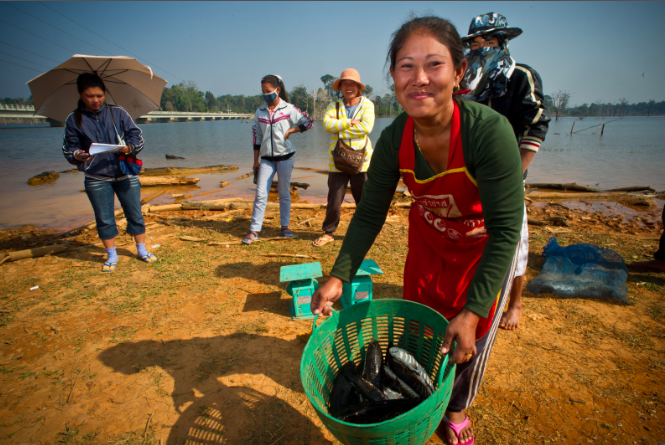This article was published by MediaGlobal News on March 16, 2012 but is no longer available on their website. It has been copied below.
UNITED NATIONS - In the theater of environmental preservation, increasing the global poor’s access to energy is usually cast as a necessary evil because it comes at the expense of the environment. Yet, given the direct correlation between adequate access to energy and poverty indicators such as life expectancy, infant mortality, and literacy rates, reducing poverty necessitates connecting the 1.6 billion people currently categorized by the International Energy Agency (IEA) as “energy poor” to some source of power.
Relocated villagers from the Nam Theun 2 Hydroelectric Project in the Khammouane province of Lao People's Democratic Republic (Laos) are now earning more from fishing and other alternative livelihoods. Photo credit: Ariel Javellana, Copyright: Asian Development Bank 2010
World Bank Vice President Rachel Kyte tells MediaGlobal that, along with access to credit, entrepreneurs in the world’s least developed countries overwhelmingly site lack of access to energy as the biggest obstacle they face in growing their businesses.
Kyte asks: “How do you provide all these people energy access without condemning them with an emissions footprint that will impact public health and leave them completely uncompetitive because they have to pay high prices for increasingly scarce fossil fuels?”
The obvious answer is to ensure new access to energy derives from renewable sources. Furthermore, for the additional 3 billion people relying on burning crop waste, dung, and wood to cook and heat their homes, it is necessary replace these traditional biomass fuels with cleaner alternatives.
Although easier said than done, it is becoming increasingly economically viable to embrace green energy. When looking to 2030 or beyond, Kyte tells MediaGlobal, “It makes good investment sense for countries to create their markets in renewable energy as well as exploiting the fossil fuel resources they have.”
Moreover, a consensus is emerging among societal stakeholders – from governments to corporations, to advocates for social justice and the environment - that making economic growth sustainable is a necessity rather than a choice.
In Asia, where the population density puts enormous pressure on the region’s comparatively limited natural resources, the imperative is even greater. “More than any other place on earth, the growth path in Asia needs to be low-carbon, it needs to be efficient on energy, on water, on everything,” insists Samuel Tumiwa, Deputy Regional Director of the Asian Development Bank. “Have you been to Ho Chi Min City? Hanoi?” he asks rhetorically. “See all those motorbikes? They are all going to be cars soon and then no one will be able to move across the city. So that’s where we need to put our heads.”
To address this problem, Secretary General Ban Ki Moon recently launched “Sustainable Energy for All,” an initiative to mobilize global action by diverse actors from business to government to academia and to meet three goals by 2030: ensure universal access to modern energy services, double the rate of improvement in energy efficiency, and double the share of renewable energy in the global energy mix.
Achieving these goals largely depends on establishing public-private partnerships whereby regulatory frameworks foster, according to Kyte, “transparency and openness in building out a grid and in allowing people to connect to that grid.” With that in place, the private sector can come in and “doing what it does best, which is to build efficiently and effectively, both power generation, but also participate in transmission and distribution of energy.”
Recognizing that potential for the private sector to drive growth in developing countries, the Asian Development Bank plans to reduce its percentage of public-sector lending from 80 percent to 50 percent by 2020. Tumiwa explains that public-private partnerships “free up government funds to support projects that get left behind because their income streams are too low to attract private investors.”
Examples of successful projects born of public-private partnerships include a recently completed transmission line capitalizing on Ethiopia’s surplus hydropower to supply electricity to Sudan. By 2016, Ethiopia will likewise export 400 megawatts of hydropower-generated electricity to Kenya at a relatively low cost. In the same vein, in Nepal a pilot wind power program provides electricity to villages in the Nawalparasi district.
Financed by the World Bank and the Asian Development Banks, respectively, Kyte says that such projects play a vital role in helping both sectors “meet the upfront costs of investing in the renewable option now so they don’t lock themselves into a pattern of infrastructure development based on fossil fuels that is going to cost them more down the line.”
Successful projects notwithstanding, risk and uncertainty compound the difficulties of establishing viable public-private partnerships in countries where the government lacks transparency. Beyond that, few incentives exist for either private or public sector leaders to take tough decisions whose benefits materialize long after the next shareholders meeting or election cycle.
Consequently, Tumiwa believes that ensuring sustainable energy access for depends on whether the international community can muster the political will to establish a binding global framework for carbon pricing. For now, he laments, the visionary leadership to implement this framework is severely lacking. In the meantime, he implores anyone with a vested interest in making development more sustainable to remember to focus on reaching small, tangible goals: “You fight the fights you can win.”

